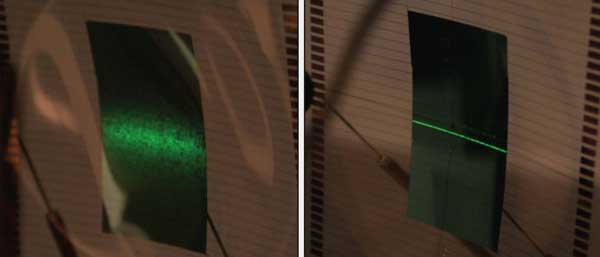Hank Hogan
Researchers at Princeton University and at Universal Display Corp. in Ewing, both in New Jersey, have constructed an organic LED (OLED) on a flat 9.5 × 9.5-cm sheet of plastic and deformed it into a dome with a radius of 8.5 cm. The device continued to work despite an average tensile strain of 2.2 percent. Possible applications include lighting and sensing.
A flexible organic LED and associated electronics could be fabricated flat and then molded onto the dashboard of a car, providing electronics, display and sensors across the surface. Another possibility is three-dimensional solid-state lighting that could be molded around objects.

Organic LEDs (OLEDs) have been made on two types of the polymer PEDOT, which can be flexed substantially and still function electronically. The images show OLEDs with a conductive Baytron P (left) and resistive Baytron P VPAI 4083 (right) PEDOT anode, seen from the underside of the dome.
“If the shaped surface is made as a photosensor array, instead of OLED array, it could be used as the sensor wrapped onto the surface of a spherical lens, like the retina is wrapped over the eyeball,” said Rabin Bhattacharya, a member of the research team as a graduate student at Princeton in the laboratory of Sigurd Wagner. He is now a scientist with Philips Research Laboratory in Eindhoven, the Netherlands.
A difficulty for nonflat displays in the past has been that OLED materials can be shaped into curves and bends but that conventional electronic materials, such as the indium-tin-oxide (ITO) anodes that provide power for the LEDs, fracture when subjected to a strain of more than approximately 1 percent. One solution has been to use small islands of ITO, a method that works but that complicates manufacturing.
In their device, the researchers replaced the ITO with a flexible anode made of a 100-nm-thick layer of the polymer PEDOT. Bhattacharya noted that PEDOT can be plastically deformed yet continue to function electronically.
He added that work at Princeton has shown that thin gold films deposited on elastomeric substrates can be stretched substantially before losing electrical conductivity. The investigators thus used thin gold electrodes in their device. They made no changes to the OLED material, a proprietary green phosphorescent material from Universal Display.
Tests showed little difference in the electrical or optical characteristics of flat and domed versions of devices constructed using two grades of PEDOT.
Research in this area continues, with work under way aimed at establishing design rules for multilayer electronics and OLED mechanics. Bhattacharya said that commercial OLEDs on flexible substrates must have an effective, inexpensive and flexible moisture barrier.
“Once this barrier process is in place, industry will come out with various experimental products,” he predicted.
Applied Physics Letters, Jan. 16, 2006, 033507.